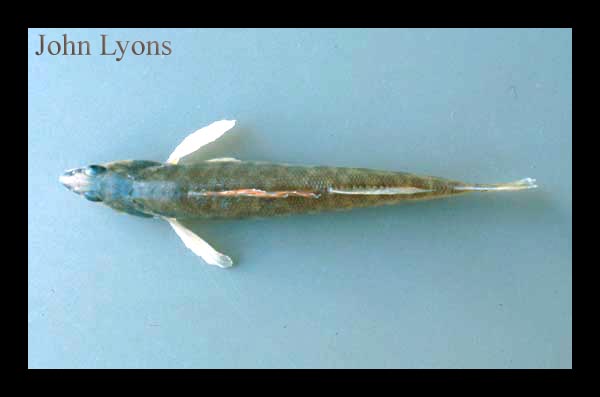Form and Function
Percina phoxocephala or the Slenderhead Darter is a medium-sized
darter with a tapered snout and black eyes.
From the eye to the tip of the snout there is a dark stripe
that faintly continues past onto the gill covering, commonly with no
teardrop. (Smith, 1979) The gill
covers on a slenderhead are medium sized and adjoin moderately at
the base of the head.
They have a thin body with small scales, ranging from 60 to 80
scales per lateral line. (Page, 1971) The top the fish is light brown/yellow in color, with darker
blotches periodically occurring along the spine. The lateral sides
of the fish tend to have 10-16 larger dark blotches, with the bottom
of the fish being pale yellow/white. (Becker,1983) Slenderheads are basically neutrally colored, besides having a
bright orange band that stretches across the fin, within this fin
are 11 or 12 medium sized dorsal spines and 11-14 soft dorsal rays.
The anal fins typically have 8 or 9 soft rays, and two spines
with a tail that is slightly forked.(Page, 1971)(Page,
1983)(Seagrant, 2012)
There are a few key characteristics when differentiating between a male and female Slenderhead. When examining the breast of this species the male anterior half of the breast is naked and the posterior is scaled, while the female breast is completely naked with the exception of one or two large scales. (Page, 1971) You can also distinguish a male from a female slenderhead by examining specialized scales found between the mid-pelvic area and the anus of males. Males also tend to have darker colored dorsal fin than female, mainly towards the base. (Becker,1983) Full grown Slenderheads range from 40 mm being the smallest, to 80 mm, regardless of sex. (Page, 1971)
A couple of the Slenderhead Darter's main
attributions that differentiates it from other species is the
narrowing of it's head into a pointed snout. This adaptation most
likely helps this species get to food in narrow or small areas.
Since the Slenderhead is found mainly in rivers and streams with
fairly strong currents so the narrowing of the body and head makes
it more hydrodynamic (notice picture of top view of Slenderhead).
 (Becker,
1983) It doesn't have apparent teeth, but there are minute, sharp
teeth on both the upper and lower jaws that are used to ingest the
variety of the diet. The dorsal fin is
segmented into two separate fins. The first fin has spines which
presumptuously evolved to protect this small fish from larger
predators. This first dorsal fin also tends to have an orange band-
with males having a thicker and more noticeable band which possibly
could function to stand out more during the
spawning periods. (Page,1983) (Texas
State University)
(Becker,
1983) It doesn't have apparent teeth, but there are minute, sharp
teeth on both the upper and lower jaws that are used to ingest the
variety of the diet. The dorsal fin is
segmented into two separate fins. The first fin has spines which
presumptuously evolved to protect this small fish from larger
predators. This first dorsal fin also tends to have an orange band-
with males having a thicker and more noticeable band which possibly
could function to stand out more during the
spawning periods. (Page,1983) (Texas
State University)
For information on other organisms like the Slenderhead Darter visit www.multipleorganisms.net
Home -
Classification -
Habitat - Nutrition
Reproduction -
Form and Function -
References - About Us

